
- Homepage
- Conflict
- Format
- Albumen (3)
- Ambrotype (32)
- Cabinet Card (66)
- Cdv (5)
- Crayon Portrait (2)
- Daguerreotype (27)
- Hardcover (14)
- Multi-formats (6)
- Negative Photo Image (4)
- Photograph (6)
- Ruby Ambrotype (3)
- Sixth Plate (2)
- Small (2)
- Stereoview (2)
- Tin Type (8)
- Tin Type Photo (2)
- Tintype (152)
- Tintype Photograph (6)
- Unknown (9)
- ... (6606)
- Photo Type
- Album (9)
- Albumen (14)
- Ambrotype (198)
- Cabinet Photo (67)
- Cdv (472)
- Cdv & Tintype (6)
- Cdvs & Tintypes (7)
- Daguerreotype (84)
- Gelatin Silver (13)
- Mixed (3)
- Negative (10)
- Negative Photo (4)
- Opalotype (4)
- Other (4)
- Photograph (4)
- Snapshot (3)
- Stereoview (23)
- Tintype (518)
- Tintypes (3)
- Unknown (12)
- ... (5499)
- Subject
- Children & Infants (21)
- Civil War (31)
- Civil War Soldier (12)
- Ethnic (17)
- Family (23)
- Fashion & Costumes (10)
- Figures & Portraits (149)
- Genealogy (10)
- Historic & Vintage (90)
- History (23)
- Men (58)
- Men, Civil War (54)
- Men, Military (39)
- Military (94)
- Military & Political (569)
- Military & War (14)
- Portrait (15)
- Portraits (14)
- Soldier (12)
- Women (19)
- ... (5683)
- Theme
- Americana (40)
- Americana, Fashion (18)
- Americana, Militaria (17)
- Antique (8)
- Art (7)
- Civil War (14)
- Conflicts & Wars (6)
- Fashion (19)
- History (43)
- History, Militaria (10)
- Love (6)
- Militaria (1017)
- Patriotic (7)
- People (21)
- Politics (14)
- Portrait (65)
- Portrait, Man (22)
- Stamps (22)
- Travel (6)
- Victorian (7)
- ... (5588)
- Type
- Belt Buckle (3)
- Carte De Visite (2)
- Cdv (3)
- Cdv Photograph (14)
- Daguerreotype (3)
- Full Cdv Photo Album (2)
- Illustrated Book (3)
- Negative Film Photo (4)
- Pendant (3)
- Photo Album (3)
- Photo Frame (2)
- Photograph (1326)
- Photograph Album (49)
- Picture Book (8)
- Picture Frames (8)
- Print (3)
- Real Photo (rppc) (10)
- Tintype (9)
- Tintype Photo (4)
- ... (5498)
Civil War Period Letter - Photographs, Mother's Marriage To Black Abolitionist
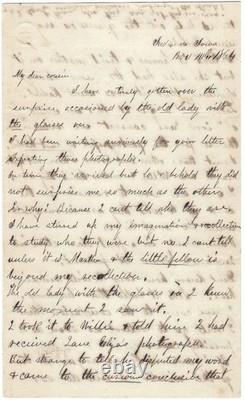
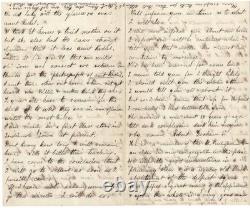
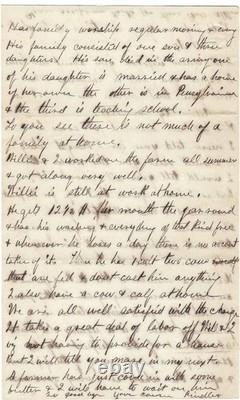
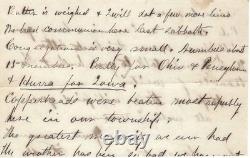
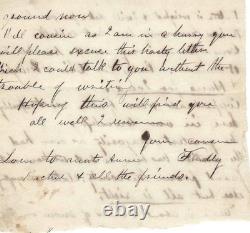


4 ½ pp, 4 ½ x 7 ½, November 10th, 1864, Findley writes to his cousin from Indianola, Iowa, with content on early photographs received and his mother marrying a "black abolitionist" who helped many oppressed people. A black abolitionist was an individual of African descent who actively advocated for the immediate end of slavery. Our writer's physical description of his step father as having a "dark complexion" supports the likelihood that he was of African descent. I had been waiting anxiously for those photographs. In time they arrived but lo & behold they did not surprise me as much as the others for why: Because I can't tell who they are. I have stirred up any imagination & recollection to study who they were but no, I can't tell unless it is Martha & the little fellow is beyond my recollection. The old lady with the glasses on I knew the moment I saw it. I took it to Willie & told him I had received Eliza's photographs. But strange to tell he disputed my word & came to the curious conclusion that the old lady with the glasses on was Aunt Rachel. I took it home & tried mother on it but she also had the same strange opinion that it was Aunt Rachel. Taking it for granted that our united opinions are correct we return our thanks for the photograph of Aunt Rachel. I sent those others out home & have not yet heard who Willie & mother think they are. So you will have to remain in the dark on who they are in our opinion until the next time. I expect you will be surprised when I tell you that mother has changed her condition by marriage... She married a man about 30 years of age, tall dark complexion, dark hair & eyes & by name Robert Graham. He is a member of the U.
Presbyterian Church, an elder in our congregation in this place. He is in pretty good circumstances in a pecuniary view & is a regular old Black abolitionist of the deepest [kind]... He has helped many of the oppressed & upon the whole is a very good man... His son died in the army..
Copperheads were beaten most superbly in our township, the greatest majority we ever had... No specific evidence links Graham to the Underground Railroad, but Iowa had a significant amount of Underground Railroad activity because of its geographic location to Missouri, a slave state to the south, and Illinois, a free state to the east. The Presbyterian and Methodist churches would sometime be a part of the Underground Railroad because people who would attempt to thwart the freeing of slaves would be watching the black churches. Slaves could move with greater safety through white churches.
Findley's description of Graham as helping many of the oppressed could be a reference to his involvement in helping to free slaves. Letter has toning, folds and some bleed through but is very readable. Our goal is to please every customer.

